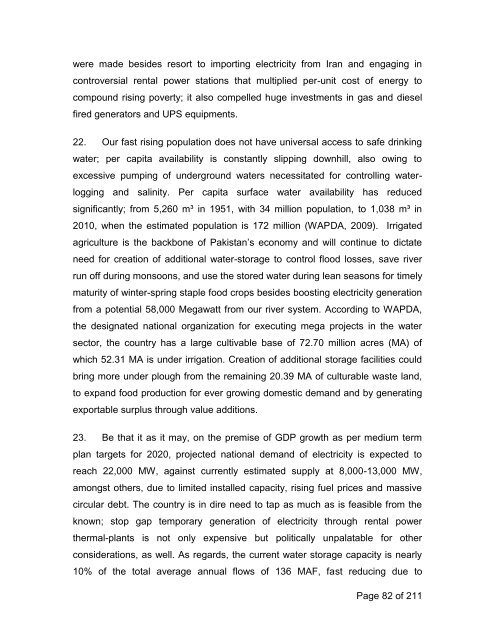Khawaja Zaheer Ahmed - PDMA
Khawaja Zaheer Ahmed - PDMA
Khawaja Zaheer Ahmed - PDMA
You also want an ePaper? Increase the reach of your titles
YUMPU automatically turns print PDFs into web optimized ePapers that Google loves.
were made besides resort to importing electricity from Iran and engaging in<br />
controversial rental power stations that multiplied per-unit cost of energy to<br />
compound rising poverty; it also compelled huge investments in gas and diesel<br />
fired generators and UPS equipments.<br />
22. Our fast rising population does not have universal access to safe drinking<br />
water; per capita availability is constantly slipping downhill, also owing to<br />
excessive pumping of underground waters necessitated for controlling water-<br />
logging and salinity. Per capita surface water availability has reduced<br />
significantly; from 5,260 m³ in 1951, with 34 million population, to 1,038 m³ in<br />
2010, when the estimated population is 172 million (WAPDA, 2009). Irrigated<br />
agriculture is the backbone of Pakistan’s economy and will continue to dictate<br />
need for creation of additional water-storage to control flood losses, save river<br />
run off during monsoons, and use the stored water during lean seasons for timely<br />
maturity of winter-spring staple food crops besides boosting electricity generation<br />
from a potential 58,000 Megawatt from our river system. According to WAPDA,<br />
the designated national organization for executing mega projects in the water<br />
sector, the country has a large cultivable base of 72.70 million acres (MA) of<br />
which 52.31 MA is under irrigation. Creation of additional storage facilities could<br />
bring more under plough from the remaining 20.39 MA of culturable waste land,<br />
to expand food production for ever growing domestic demand and by generating<br />
exportable surplus through value additions.<br />
23. Be that it as it may, on the premise of GDP growth as per medium term<br />
plan targets for 2020, projected national demand of electricity is expected to<br />
reach 22,000 MW, against currently estimated supply at 8,000-13,000 MW,<br />
amongst others, due to limited installed capacity, rising fuel prices and massive<br />
circular debt. The country is in dire need to tap as much as is feasible from the<br />
known; stop gap temporary generation of electricity through rental power<br />
thermal-plants is not only expensive but politically unpalatable for other<br />
considerations, as well. As regards, the current water storage capacity is nearly<br />
10% of the total average annual flows of 136 MAF, fast reducing due to<br />
Page 82 of 211


